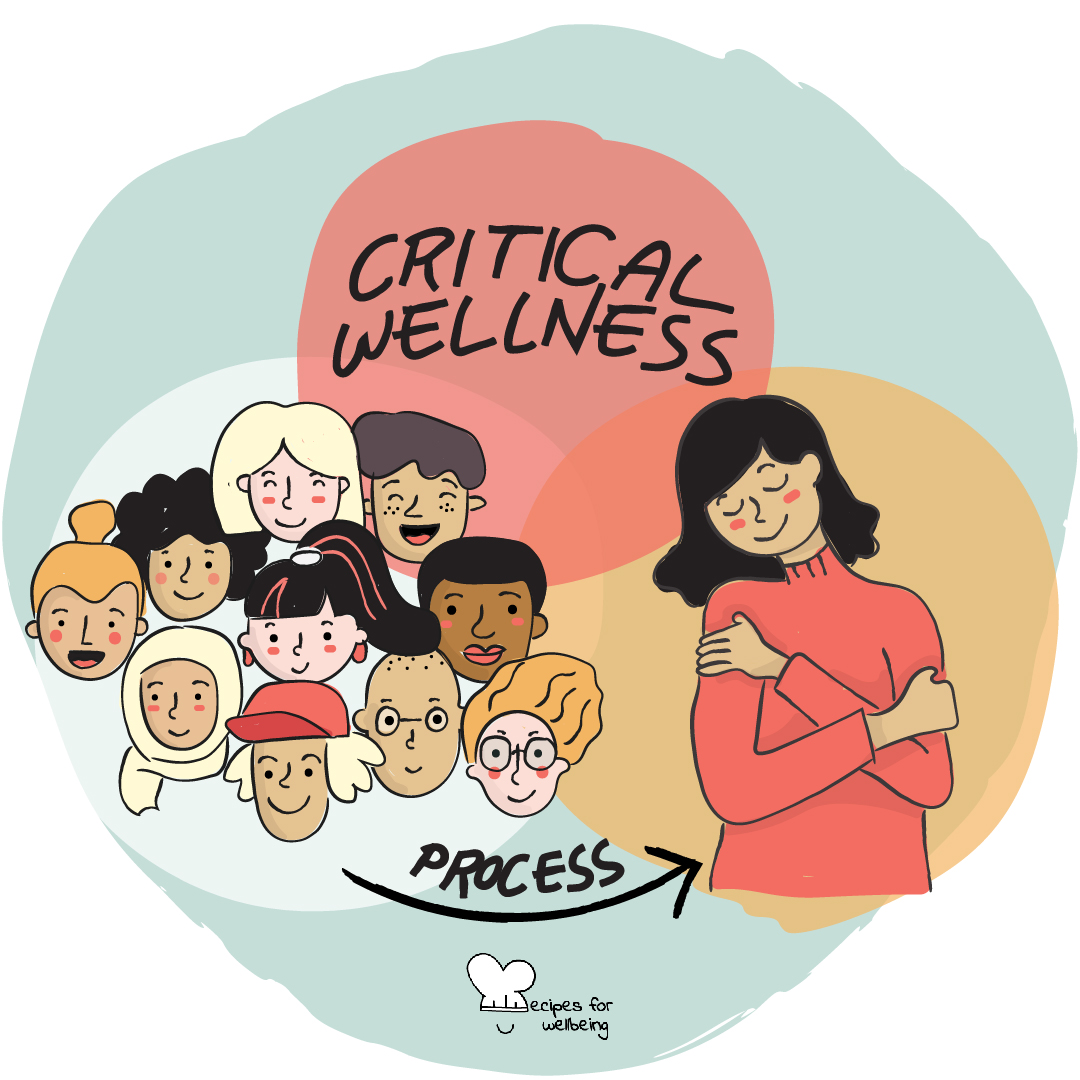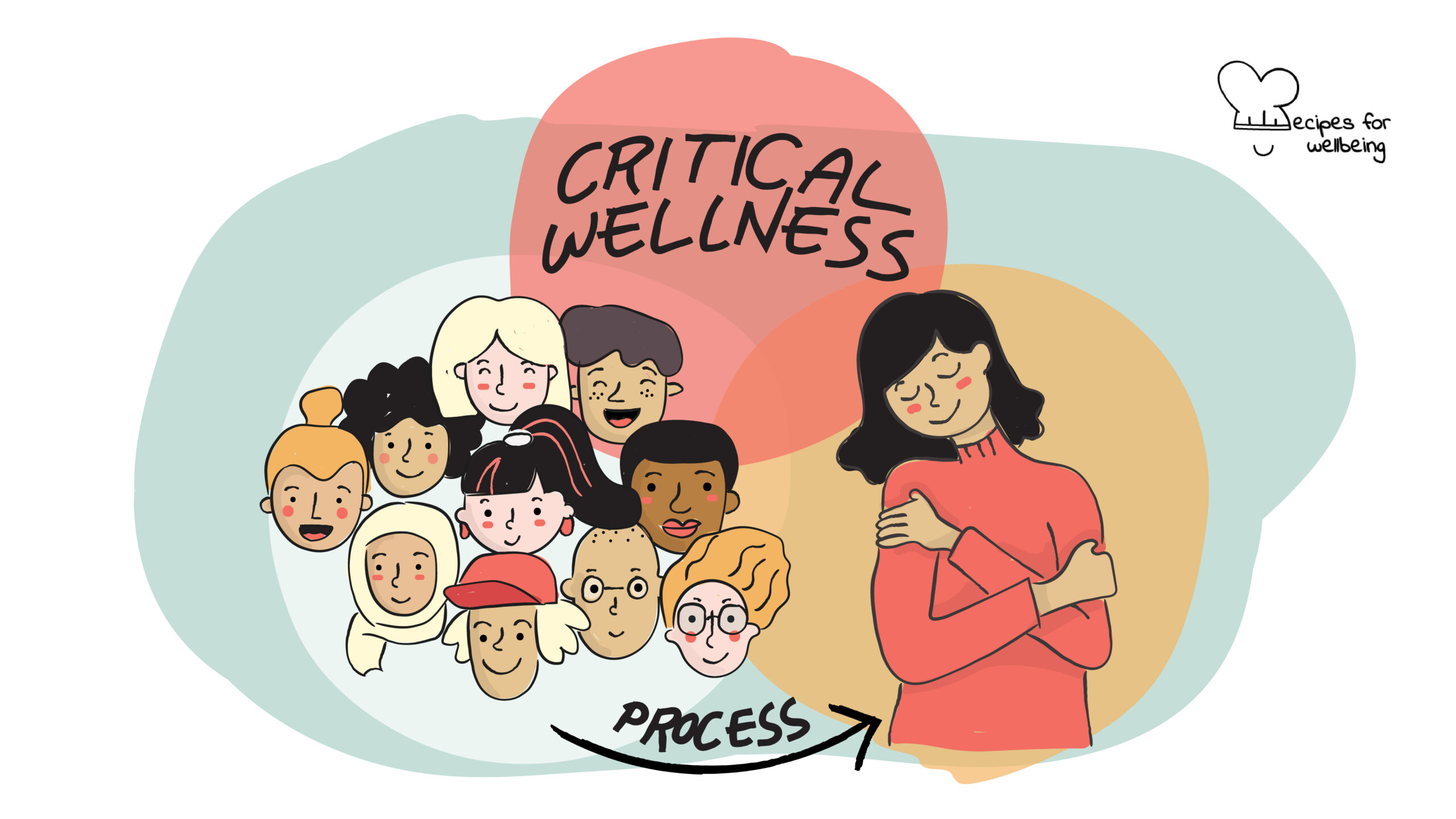
5 steps towards “critical wellness” to overcome racism
Personal power really begins with care of the self. ―bell hooks
👥 Serves: 1 person
🎚 Difficulty: Hard
⏳ Total time: Ongoing
🥣 Ingredients: 1 pen, 1 sheet of paper, a community, self-reflection, honesty, will, hope
🤓 Wholebeing Domains: Discomfortability, Liberatory Learning
💪 Wholebeing Skills: Acceptance, Accountability, Belonging, Boundary setting, Challenging, Community-building, Dealing with shame, Honesty, Liberation, Reflection

5 steps towards “critical wellness” to overcome racism
📝 Description
A five-step process to heal from the wounds of racism and discrimination.
“Choosing wellness” is one of the most political wellbeing recipes for black, indigenous, and people of colour (BIPoC). Throughout history, marginalised people were not supposed to do well or be happy and healthy. They were supposed to work and serve white, supremacist, capitalist patriarchy, work in the fields during slavery, or give up their land and properties during colonisation. Millions of black, indigenous, and people of colour died during those times. But even today racism continues to be a source of stress and illness, also referred to as racism-based stress. Like other types of stress, racism-based stress affects the mind, body, heart, and spirit so it is important to address it on a holistic level. “Choosing wellness” means choosing to focus on one’s own mental, physical, emotional, and spiritual wellbeing. It is about developing the resilience needed to not let oppression impact your self-worth.
The following recipe has been kindly donated by Mariela Georg, stress coach, empowerment and wellness trainer. This activity sees wellness as an empowering and radical form of political resistance. It suggests a process for black, indigenous, and people of colour to heal themselves from the wounds of racism and discrimination. Find out more about Mariela’s work at https://empower-mental.de.
👣 Steps
Step 1 – Honest self-reflection
You might be constantly asking yourself: “What can I do about racism? How can I respond to micro-aggressions and racist situations?” But in doing so, you allow yourself to be colonised again. The coloniser is on your mind as you keep asking yourself what you should have done, how you should have better counter-acted the oppressor and defended yourself. So, take a sheet of paper and a pen and write down the following question: “What does racism do to me?” Write down how your mind, body, heart, and spirit are affected by racism. What thoughts pop up in your mind, what physical sensations emerge in your body, what feelings does your heart experience?
Step 2 – Do some research
At this point, reflect on the “critical” part of Critical Wellness. This means reading about internalised oppression, internalised racism, racism and trauma, as well as intersectionality, kyriarchy, critical liberation theory, and black feminism to name a few. No one is going to do this research for you, so do it yourself before moving onto the “wellness” part of Critical Wellness. But if you are really stuck and don’t know where to begin, here are a few articles you might want to check out:
- “Understanding Internalized Oppression: A Theoretical Understanding of Internalized Subordination” by Teeomm K. Williams
- “Healing from the Effects of Internalized Oppression” by Community Toolbox
- “Critical Liberation Theory” by Barbara J. Love, Keri DeJong, Christopher Hughbanks
- “Black Feminist Thought” by Patricia Hill Collins
- “Black Skin, White Masks” by Frantz Fanon
- “Plantation Memories” by Grada Kilomba
Step 3 – Choose wellness and self-care
Now that you know how racism affects you, it is time to explore ways in which you can cultivate self-care, self-recovery, and self-love. This is where your wellness journey truly begins and making the conscious effort to self-care will strengthen and empower your identity. It will also equip you with the resilience needed to overcome racist situations and to engage in collective action, political resistance, and community-care. If you are unsure about self-care practices, here are some ideas:
- Healing the mind: talking with an empathic person with similar experiences, talking with a coach, narrative therapy, journaling, affirmations, reading empowering books, listening to empowering podcasts, watching movies with BIPoC protagonists, empowering quotes, etc.
- Healing the body: massage, fascial release, dancing, running fast, high-intensity interval training (HIIT), weight-lifting, eating healthy whole foods, no alcohol, drugs, or nicotine, etc.
- Healing the heart: being aware of your emotions and needs, taking time to reflect how you are feeling on all levels, writing down your emotions and finding words or images to describe what you are feeling, journaling your emotions and looking back at your entries to see how you change and grow.
- Healing the spirit: yoga, meditation, practising daily gratitude, reading, re-discovering ancestral rituals, empowering music, expressionist art and theatre, rediscovering Mother Earth and your bondage to Nature.
Step 4 – Write a self-care checklist
After exploring different strategies, choose the ones that suit you the most. Write a self-care checklist with wellbeing strategies and activities for each of the four levels mentioned above (mental, physical, emotional, and spiritual). Practise the chosen strategies every week, every month, every year. Make sure to take time every so often to review your progress and update your checklist.
Step 5 – Community-care
Exchange your experiences and strategies with other people so you can go on a common journey. Critical Wellness is an ongoing process rather than an end-state, so make sure to share this journey with others. Ubuntu philosophy reminds us, “You can’t take someone on a journey you haven’t travelled yourself” which is the reason why community features as the last step in this process.

